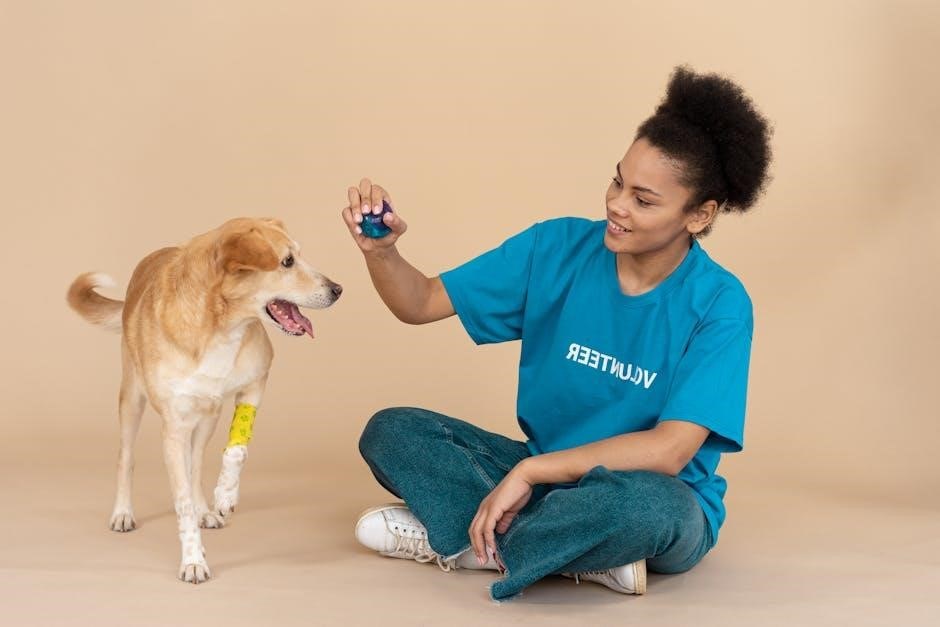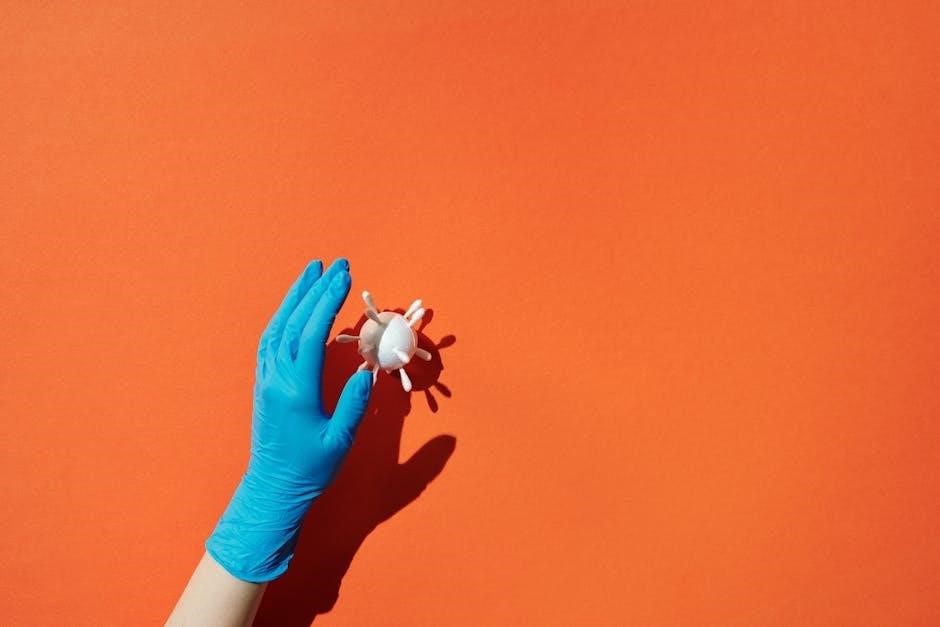Ball Python Care Sheet: A Comprehensive Guide
Ball pythons make wonderful pets due to their calm nature and manageable care. This guide provides essential tips on habitat setup‚ feeding‚ and health to ensure your pet thrives. Download our detailed care sheet today for a happy‚ healthy ball python.
Biological Facts and Overview

The ball python (Python regius) is a non-venomous constrictor native to sub-Saharan Africa‚ particularly in grasslands and savannahs. Also known as the royal python‚ it is the smallest African python species‚ typically growing 3-5 feet in length and weighing 3-7 pounds. Ball pythons are recognized for their stocky build and calm demeanor‚ making them a popular choice as pets. They are nocturnal and solitary animals‚ often curling into a tight “ball” for defense‚ which inspired their name. In captivity‚ with proper care‚ ball pythons can live up to 30 years‚ making them a long-term commitment. Juvenile ball pythons reach adult size in about three years. Their natural behavior involves hunting small mammals‚ and they are well-known for their array of colorful morphs. Despite their shy nature‚ ball pythons are generally docile and adaptable to captivity‚ provided appropriate conditions are met. Their biology and behavior make them an ideal species for both experienced enthusiasts and newcomers to reptile care.


Habitat Setup and Requirements
Setting up the right habitat is crucial for the health and well-being of your ball python. A secure‚ well-ventilated enclosure is essential‚ as ball pythons are skilled escape artists. For adult ball pythons‚ a minimum enclosure size of 4x2x2 feet (120 gallons) is recommended‚ while juveniles can start in a 40-gallon enclosure. The substrate should be safe and easy to clean‚ such as aspen‚ reptile carpet‚ or paper towels. Avoid loose substrates like sand‚ which can cause respiratory issues; Temperature is a critical factor‚ with a basking spot of 88-96°F and an ambient temperature of 78-80°F. Use a high-quality heat source and thermometer to monitor conditions. Humidity levels should be maintained at 50-60%‚ increasing to 70% during shedding cycles. Proper ventilation is necessary to prevent respiratory problems. Include hiding places‚ such as logs or commercial hides‚ to reduce stress. A shallow‚ heavy water dish should always be available for drinking. Regular cleaning of the enclosure is vital to prevent bacterial growth‚ with spot cleans daily and a full clean every 4-6 weeks.

Feeding and Dietary Needs

Ball pythons are carnivores and primarily feed on small mammals like mice and rats. Young ball pythons should be fed weekly‚ while adults can be fed every 10-14 days. The prey size should match the snake’s mid-body girth to ensure safe consumption. Pre-killed or frozen-thawed prey is recommended to avoid injuries from live prey. Feeding live prey can pose risks‚ as rodents may bite the snake. A feeding schedule of every 7-10 days for the first 2-3 years is ideal‚ transitioning to every two weeks thereafter to prevent obesity. Ball pythons do not need to eat daily‚ even in their youth. Supplements like calcium and multivitamins can be used occasionally‚ but gut-loading prey is often sufficient. Fresh water should always be available‚ with a shallow‚ heavy dish for drinking and soaking during shedding cycles. Soaking helps with skin shedding‚ promoting healthy scales. Proper feeding practices ensure optimal growth and long-term health for your ball python.
Health and Hygiene
Ball pythons are generally hardy snakes‚ but proper hygiene and health monitoring are essential to prevent issues. Regular cleaning of the enclosure is crucial to remove feces‚ uneaten prey‚ and shed skin. Spot clean daily‚ and perform a full enclosure cleaning every 4-6 weeks using a reptile-safe disinfectant like a diluted bleach solution. Rinse thoroughly to avoid chemical residue. Fresh water should be provided daily to prevent bacterial growth and ensure hydration. A clean environment reduces the risk of respiratory infections and other health problems. Ball pythons can be prone to mites‚ so inspect your snake regularly for signs of infestation. Shedding issues may require a soak in a shallow‚ warm water dish or a dilute betadine solution to aid skin removal. Maintain proper humidity levels (50-60%) to support healthy shedding and skin condition. Regularly monitor your snake’s behavior‚ appetite‚ and stool quality for signs of illness‚ such as lethargy or regurgitation. Early detection of health issues ensures timely veterinary care and promotes long-term well-being.
Handling and Behavior
Ball pythons are known for their calm and docile nature‚ making them an excellent choice for both experienced and novice snake owners. They are generally shy snakes and may curl into a tight ball when stressed or frightened‚ which is where they get their name. Handling should be done gently and calmly to avoid causing unnecessary stress. Start with short sessions‚ especially with younger or newer pets‚ and gradually increase interaction time as they become more comfortable. Always support the snake’s body during handling to prevent discomfort or injury. Ball pythons are nocturnal‚ so they may be more active at night‚ but they can still be handled during the day. Avoid handling your snake immediately after feeding or shedding‚ as this can cause stress or discomfort. With patience and consistent interaction‚ ball pythons can become very tame and enjoyable pets.
Breeding and Reproduction
Breeding ball pythons requires careful planning and attention to detail. These snakes typically reach reproductive maturity between 3 to 5 years of age‚ with males usually maturing earlier than females. Breeding season occurs in the fall‚ and males should be introduced to females during this time. Proper temperature and humidity levels are crucial for successful breeding‚ with a slight drop in temperature often triggering courtship behavior. After mating‚ females will gestate for approximately 80 days before laying a clutch of eggs‚ usually ranging from 3 to 11 eggs. Incubation temperature plays a significant role in determining the sex of the hatchlings. Breeding ball pythons can be a rewarding experience but should only be attempted by experienced keepers. Ensure both males and females are healthy and well-conditioned before breeding to increase the likelihood of a successful outcome.
Tips for Beginners
If you’re new to ball python ownership‚ start by ensuring you provide the right environment. A 30-40 gallon enclosure is ideal for juveniles‚ while adults may need larger spaces. Maintain proper temperature gradients (78-88°F for ambient and 90-95°F for basking) and humidity levels (50-60%). Avoid housing multiple snakes together‚ as they prefer solitude. Feeding pre-killed prey is recommended to prevent injury‚ and feedings should occur every 7-10 days for younger snakes‚ reducing frequency as they mature. Handle gently and briefly‚ especially in the early stages‚ to help your ball python become tame. Research local laws and ensure you’re prepared for a long-term commitment‚ as ball pythons can live up to 30 years. Lastly‚ keep the enclosure clean with regular spot cleans and avoid using loose substrates like sand to prevent respiratory issues. With patience and proper care‚ your ball python will thrive.
Common Mistakes to Avoid

One of the most common mistakes ball python owners make is housing multiple snakes together‚ which can lead to stress and aggression. Another error is improper temperature and humidity levels; ensure a gradient of 78-88°F for ambient temperature and 90-95°F for basking‚ with humidity maintained at 50-60%. Overfeeding is also prevalent‚ as ball pythons can become overweight if fed too frequently. Avoid feeding prey larger than the snake’s mid-body girth. Using incorrect substrates like sand or wood shavings can cause respiratory issues‚ so opt for safer options like paper towels or reptile carpet. Neglecting hiding places is another mistake‚ as ball pythons need places to feel secure. Lastly‚ many owners underestimate the importance of regular cleaning‚ which can lead to health problems. By avoiding these common pitfalls‚ you can ensure a healthy and happy ball python.
Advanced Care Techniques
For experienced ball python keepers‚ advanced care techniques can enhance the health and well-being of your pet. Implementing a precise temperature gradient‚ with a basking spot of 90-95°F and ambient temperatures of 78-80°F‚ ensures optimal thermoregulation. Maintaining humidity levels between 50-60%‚ with increased humidity during shedding (up to 70%)‚ promotes smooth skin shedding. Consider using a hygrometer for accurate monitoring. Advanced feeding strategies include offering prey items of varying sizes to stimulate natural hunting behavior and alternating between mice and rats for dietary diversity. Some keepers also use prey scenting techniques to encourage feeding in picky eaters. Additionally‚ incorporating enrichment elements like live plants‚ climbing structures‚ or substrate changes can stimulate your ball python’s natural foraging instincts. Regular weight monitoring‚ especially for breeding purposes‚ is another advanced practice. Finally‚ periodic fecal exams and parasite checks ensure long-term health. By mastering these techniques‚ you can provide a tailored‚ enrichment-focused environment for your ball python.


